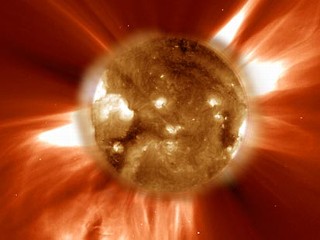U.S. scientists worry we aren't ready for a solar space storm that could knock out our electricity, our cell phones, even our water supply.
The chances of that happening are small, but it is a possibility as we move into an active period of solar storms.
How do they know? Well, it's happened before. Back in 1859, a solar eruption resulted in telegraph wires burning up.
Of course, the world is now covered in wires and wireless devices that could be vulnerable.
The National Academy of Sciences (NAS) gathered experts from around the country to look at the economic and social costs from these space storms. While they didn't make any recommendations, the scientists hope their report is a wake-up call.
"We're not trying to be alarmist," said Dan Baker, who is the lead author of the report, "but we are trying to show how our systems are interconnected."
The sun is on a fairly regular schedule. Every 11 years, solar activity flares up. The next "maximum" active period is expected in 2012.
During those active times, the sun spits billions of tons of matter toward Earth that can cause electromagnetic storms that interfere with just about all of our electronic systems.
How bad would the "Katrina Space Storm" be for us earthlings? Well, the NAS report suggests the storm could cascade through our modern world.
First, the electric grid would be vulnerable, and could be shut down. It's the first big domino that, the report says, could lead to "disruption of the transportation, communication, banking, and finance systems, and government services; the breakdown of the distribution of potable water owing to pump failure; and the loss of perishable foods and medications because of lack of refrigeration."
Not a pretty picture. The scientists say if even one region or country is affected, the problems could spread to the rest of the world.
If you thought Katrina was expensive, this space storm would dwarf it. The report estimates "$1 trillion to $2 trillion during the first year alone ... for the societal and economic costs of a 'severe geomagnetic storm scenario' with recovery times of four to 10 years."
Might Have to Go Analog
Satellites and GPS systems could be knocked out.
As ABC's Clayton Sandell has written for this site before: "Solar storms could make GPS receivers unable to lock onto a satellite signal, rendering them useless. The effect could last for minutes or more than a day. You may be reduced to -- gasp -- stopping to ask for directions."
"The civilian use of GPS has really taken off only in the last few years, so we really do expect to see a much wider impact in this upcoming cycle," said Douglas Biesecker, a solar physicist at the Space Weather Prediction Center in Colorado, run by the National Oceanic and Atmospheric Administration.
Sales of so-called personal navigation devices -- those manufactured by companies like Magellan and Garmin, for example -- have skyrocketed in recent years. In 2004, worldwide sales of GPS units were about 2 million. By 2007, that number had jumped to about 27 million, according to technology analysts at ABI Research.
A failure of the GPS system could have serious ramifications for flying. The Federal Aviation Administration is trying to move to an air traffic control system based on GPS.
But the country is not making a lot of plans for the next big solar storm.
"Our society isn't geared toward dealing with these kinds of possibilities," said Baker, referring to the fact that a huge solar storm is a rare occurrence. "We are more concerned with short-term possibilities."
Solar weather isn't like the weather here on Earth. Meteorologists can track a storm for days and give residents plenty of warning of what is coming. That's not the case with space weather.
"We can't predict [a coming space storm] with any great lead time of accuracy," Baker said.
What he and his colleagues can predict is that we are not ready for "the big one" when it comes to solar storms.




No comments:
Post a Comment